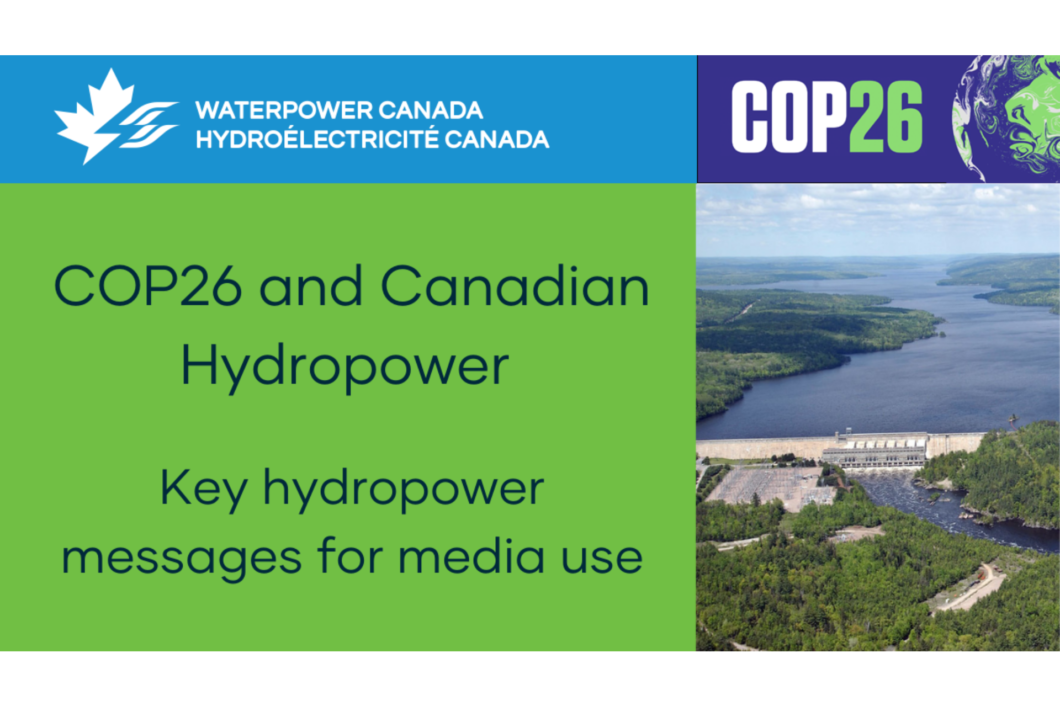As the world gathers in Glasgow for COP26, all eyes are on clean-energy solutions that can effectively address climate change and set the world on a real path to net-zero emissions by 2050.
During this critical time, we invite media to reach out to us for any questions as they cover COP26.
To help with balanced coverage, we are providing facts below and in pdf here that are based on science, best practices and years of data monitoring both from the hydropower industry and governments.
We also invite our members and stakeholders to share these key messages through social media via social cards that we prepared.
Canadian waterpower 101
- Waterpower provides 60% of our overall electricity.
- Waterpower is the only clean, renewable and abundant source of electricity that is always-available and easily ramped up and down to meet system-wide needs. Waterpower turbines can rapidly go from zero to full power, while storage capacity in waterways and reservoirs can enable these projects to address both time-of-day and seasonal demand variation.
- Waterpower is the main source of renewable electricity in Canada (90% of the renewable generation comes from waterpower): waterpower harnesses the movement of water to produce electricity. Water is not consumed, polluted or wasted in the process.
- Canada has more than 500 waterpower facilities from coast to coast, with the earliest site built in the 1890s. They vary in size and technology. There are four main types of facilities in Canada; reservoir, run-of-river, pumped storage and hydrokinetic.
Canadian waterpower and the environment
- With 60% of our electricity generation coming from ultra-low emissions waterpower, Canada’s electricity is one of the cleanest of all G20 nations. The lifecycle GHG emissions from Canadian hydroelectricity are minimal in comparison to fossil-fueled electricity generation. While there are variances from facility to facility, a range of 2 – 17 t CO2e / GWh is representative of the majority Canadian hydroelectricity generation fleet. This is comparable to those from wind-powered electricity generation, for example, which is 12 t CO2e / GWh, and significantly lower than fossil fuel generation. (Source: National Renewable Energy Laboratory (NREL)’s “Lifecycle Assessment Harmonization” project.)
- It is a common misperception that Canadian hydropower reservoirs are significant sources of the powerful greenhouse gas methane. Both natural and artificial waterbodies do emit methane. But methane production is a function of climate and oxygenation. Hydropower reservoirs in Canada are colder and more oxygenated that the global average. Therefore, and for example, the methane emissions from boreal and northern hydropower reservoirs in Canada cannot and should not be equated to those in the balmy tropics.
Canadian waterpower and electrification to meet net zero
- There is as much more undeveloped waterpower generation capacity in Canada today as there is developed. Meanwhile, the efficiency, capacity and operating lives of many existing projects are being extended through refurbishments.
- Large-scale waterpower projects represent major investments, but produce electricity with a high value at an affordable price. These projects operate for many decades, with low operating and zero fuel costs, and provide a hedge against the price volatility of other forms of generation. In Canada today, the lowest-electricity prices are in the provinces with the most waterpower generation.
- Waterpower will be the backbone of our new energy system; waterpower will be an indispensable component of the new and necessarily more complex energy system that is already emerging. This system will feature growing proportions of electricity from widely dispersed, variably scaled, non-emitting and renewable sources.
- This system will therefore also need to feature flexible generation sources, with extensive storage capacity, and able to deliver on-demand electricity. Only with that complementarity of system design will we be able to effectively balance supply and demand, and capture the full potential of intermittent sources of electricity such as wind and solar.
- Canada needs more investments in green infrastructure. There are no better means of providing that complementarity of design than ongoing and accelerated investment in both waterpower generation – with its highly reliable availability – and in the expanded transmission capacity that will enable all regions of Canada to share in the benefits of waterpower.
- Waterpower’s importance is therefore poised to grow, even as we leverage new and potentially transformative energy opportunities.
About WaterPower Canada (WPC)
Founded in 1998, WaterPower Canada (WPC) is the national, not-for-profit trade association dedicated to representing the waterpower industry. Its many members span the breadth of the sector and include hydropower producers, manufacturers, developers, engineering firms and other organizations. WaterPower Canada members represent more than 95% of the waterpower installed capacity in Canada, advocating for the responsible development and use of waterpower to meet our present and future electricity needs in a sustainable manner.
Find us on Twitter and LinkedIn. Subscribe to our newsletter. Learn more at waterpowercanada.ca.
For more information or for interview opportunities, please contact:
Anastasia Smolentseva, Communications Director
WaterPower Canada
613-857-3359
anastasia@waterpowercanada.ca

